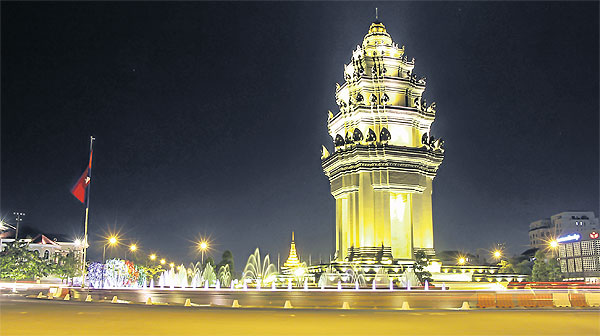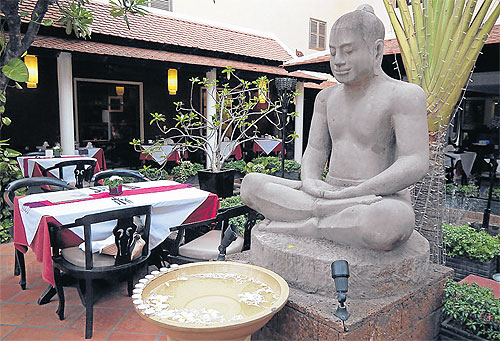In a quiet alcove of Phnom Penh’s National Museum, two young Cambodians, eyes wide with wonder, watch the grainy, fairytale images of a film shot in their quiet capital in the mid-1960s. They observe smartly dressed Khmer strolling down tree-lined, Parisian-style boulevards with gushing fountains, set to a background of classical Western music.
While this romantic image was destroyed as unimaginable horrors visited Cambodia in the 1970s, today these scenes are echoed in the majestic median-strip parks of boulevards and other green spaces of the still-quaint city, enjoyed by locals picnicking, laughing and lounging. Or, on one recent evening at Wat Botum Park, partaking in what at first glimpse seems to be a Bangkok-style group aerobics session, but turns out to be a quirky, slower assortment of dance moves drawing from both traditional inspirations such as the hand-swirling Khmer-style ram wong and (relatively) newer ones, such as the Twist.
Effervescence is energising this awakening city, as art galleries proliferate in up-and-coming areas such as Street 340, skyscrapers shoot up behind French-era villas restored in classic colonial yellow, tourist arrival numbers skyrocket and the arrival of international cafe culture creates air-conditioned alternatives to sweet and strong street-side Khmer coffee.
On a recent sunny morning when it was temporarily closed to traffic, an emptier Norodom Boulevard again looked how this leafy, stately area surrounding Independence Monument did in the opening scene of Apsara, one of many films directed in the 1960s by Cambodia’s once and future king, Norodom Sihanouk, who defined an era now often called a golden age. A jazzy version of Sihanouk’s catchy The Night I Met You plays as a car in the scene zips past the tower, which celebrates the country’s peaceful winning of freedom from France in 1953.
Across town just off another elegant tree-lined boulevard, it’s easy to imagine the gentler, classic version of this composition being played in the 1920s-era Raffles Le Royal Phnom Penh under the arches in the high ceiling of the legendary Elephant Bar, where Prince Sihanouk once famously entertained Jackie Kennedy, and chicness continues to reign.
As the timeless elegance of the surroundings seeps in, you’ll notice the elephants slowly emerging from pretty much everywhere, from the silver candlesticks to the Oriental carpet and carved woodwork of the tables to the painted ceilings overhead.
A short, scenic walk from here around the landmark Wat Phnom will lead to the stunning Sisowath Quay, warm breezes lend life to the fronds of palm trees and national flags smartly lining the riverfront promenade, as local families snack at stalls selling baguettes stuffed with pate and pickled vegetables and noodle soups, which proliferate after sunset.
After ending a day in Phnom Penh, perhaps between recovering from the sobering Killing Fields or Toul Seng Genocide Museum and before peering into the Heart of Darkness, a popular nightspot for watching an eclectic mix of characters, one opportunity to take respite in traditional Khmer culture comes in the form of the Plae Pakaa performances at the National Museum.
Ranked by Trip Advisor as Phnom Penh’s No 2 attraction, after holding the top position from 2011-13, it is the kingdom’s showcase example for breathing new life into a culture decimated in Khmer Rouge era, during which it is estimated that 90% of the country’s artists were executed.
Held several nights a week at 7pm in an outdoor theatre surrounded by lush gardens, Plae Pakaa — which expresses the idea of “coming to fruition” in Khmer — features three rotating shows: classical performances from the Children of Bassac troupe, such as the legendary apsara dances and Golden Mermaid story from the Reamker (Ramayana); Yike, or Cambodian theatre and folk dances, some of which are distant cousins to Thai likay; and Passage of Life. The last of these theatrically encapsulates in a movingly down-to-earth way how ceremonies such as birth, coming of age, marriage and even dealing with spirit possession were marked in Cambodian villages.
The shows, presented by the non-profit group Cambodian Living Arts (CLA), founded by genocide survivor Arn Chorn-pond. He began CLA in 1998 out of a passion to preserve Cambodian artistry, and, as he said, “to see every Khmer child have the chance to know his culture, to live it, and to make it richer”.
In the 1980s in Cambodian refugee camps in Thailand, to help keep the spirit of their culture alive, Arn Chorn-pond would often play his flute as an accompaniment to the classical dancing of Princess Bopha Devi, whose artistry also graces her father’s film Apsara.
Sacred apsara performances, once held for god-kings in the monumental temples of Angkor, where the smiling faces and elegant figures of these celestial beings are forever carved in stone, and other classical dances today symbolise the rich culture of a nation that has survived the seemingly unsurvivable.
One of the young, dedicated Plae Pakaa performers working to ensure the longevity of the culture he loves is Soy Chanborey. When skittering across the stage, devouring a pretend banana or just giving himself a good scratch as a little monkey he plays in the Golden Mermaid, the dancer summons the liveliness of the rascally monkeys he’s observed countless times in the hillside forest surrounding Wat Phnom, not far from his family’s modest home.
“It took a long time learning how to become a monkey,” says Soy Chanborey. He displays subtler acting skills as the monkey king Hanuman, as well as the brute strength and stomping prowess of a yak, or giant, in Reamker-focused demonstration shows CLA often puts on across the country. He says Cambodians young and old are enthusiastically responding to such performances, often presenting him with garlands or even invitations to visit their homes. At the CLA centre in Phnom Penh, the Arn Chorn-pond Living Arts Scholarship recipient is putting folk dances such as the lively coconut-shell and fishing dances into his Khmer arts repertoire. He has put more than a decade of hard work into honing classical lakhon khaol mask dance skills at Cambodia’s Secondary School of Fine Arts and the University of Fine Arts, where he’s in his third year. In the CLA classes, he’s learning to become human again, or at least a bit less mythological.
“Before I never had the chance to smile on stage as I wear a mask, but now I do in the folk dances. Sometimes the instructors would press down so hard that I cried.”
Soy Chanborey explains that an instructor would firmly apply pressure on the dancer’s thigh with his foot, to help build muscle. While the first five years were very physically demanding, he eventually grew more muscular, and adroit at holding difficult positions, such as keeping one foot high in the air, skills required of little monkeys and giants alike. While optimistic about his chances of helping support his parents and two young sisters as a dancer, and ultimately becoming a choreographer, for now Soy Chanborey often helps his mother cook fried noodles from the cart she earns an income from every day near their home.
Soy Chanborey is one of dozens of young Cambodian exemplifying CLA’s mission “to facilitate the transformation of Cambodia through the arts”. Another is chapei musician Kong Gne, who along with a few fellow classmates became so hooked on playing this two-stringed, long-necked Khmer-style guitar at CLA, that they founded the Chapey Dong Weng Art Community, a troupe that played to a packed house in February at the Doors, a hip music lounge in the capital’s old French Quarter. The gig represents a growing enthusiasm for traditional Khmer arts in Phnom Penh.
Helping young Khmer on the way towards a sustainable future are CLA instructors like Nhok Sinat, a music ensemble leader in Passage of Life. Serene and thoughtful in an interview before a recent show at the National Museum, he saves his deepest enthusiasm for the show itself, saying “when you’re onstage, playing with passion is a must”. He masterfully coaxes shrill but soulful sounds out of the tro khmer, a two-string, one-coconut-shell instrument played as part of the pinpeat orchestral ensemble that provides mood-setting accompaniment.
“Tourists and locals come here because Plae Pakaa provides the best-quality Cambodian cultural performances in the whole country,” he says. “Most of the performers are young people, and are learning great skills that can lead to a career.”
Raised in very modest surroundings in Siem Reap, where he was once a temple boy at Wat Bo, Nhok Sinat now finds himself in demand to perform at weddings, putting to use the seven years he spent mastering classical wedding music in CLA classes, and cultivating his lifelong passion for his country’s music.
Most CLA artists come from poor backgrounds, and many from communities affected by the waves of evictions that preceded development in parts of Phnom Penh, including the White Building and nearby Dey Krahom, where artists’ communities were established in the 1980s.
Travellers moved by the Plae Pakaa shows can supplement the experience by taking a Cambodian Living Arts tour, and watch instructors and students interact in classes, such as pinpeat classes at Wat Lanka or chapei classes at the CLA centre.
“CLA is a springboard to self-sustainability for these artists,” says the organisation’s communications manager, Marion Gommard. “Cambodia has largely been depicted as a ‘victim’ country, with poor kids around every corner. This doesn’t reflect today’s reality, where a new generation of very dynamic young adults are changing the face of the country, including the emerging artists and arts professionals we are working with, who show great motivation and talent.”
While Cambodia remains challenged by problems such as widespread poverty, travellers there will find a wealth of cultural options to choose from, as the dreams of societal development of departed Father King Sihanouk and artistic vision of Arn Chorn-pond in Cambodian Living Arts seem slowly being realised.
The optimism permeating a city on the rise wafts through the air along with the subtle herbs of Cambodian curries, similar to but gentler than their spicier Thai counterparts, in the garden setting of Malis, commonly regarded as the best restaurant in town for up-market Cambodian food. It’s an ideal venue for savouring amok, the national dish, or splurging on Battambang beef steak. From the lemongrass towels and mango welcome drinks to creative courses living up their billing as “living Cambodian cuisine”, this modern Phnom Penh institution exudes a distinct sense of Khmer chic.
Upon entering the restaurant, guests are greeted by a prominently positioned stone figure recalling the National Museum’s iconic image of mighty Angkorian monarch Jayavarman VII in a meditative moment. With closed eyes, he bears what a museum plaque describes “a particular facial expression known as the ‘Smile of Angkor’ ” which “Khmer sculpture is characterised by”.
Beyond the museum’s showpiece, the massive head and two arms of a Reclining Vishnu that once would have stretched 6m, past halls of countless other huge images of the god, Shiva and other Hindu deities, monolithic reminders of Southeast Asia’s greatest empire, stands a display cabinet displaying the finery of apsara dancers. When distilled through the panes of old, warped glass, the golden objets d’art within — collars, breastplates, pendants, and ethereal tiaras — may seem to shimmy like a distant mirage, taking on a dreamlike quality, while the shinier versions of such ornaments adorning the living apsara in Plae Pakaa performances, held just outside in evenings, represent a thriving culture that is very much alive, and evocative as ever. n
CLA’s low-season performances of the Children of Bassac troupe and 'Yike' will be held until September, while the three rotating shows of Plae Pakaa for the high season start again in October. For further details about these and Cambodian Living Arts tours, visit www.cambodianlivingarts.org. Flights from Bangkok to Phnom Penh start from about 5,400 baht.











